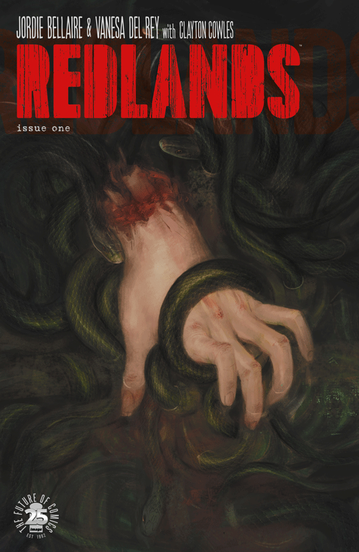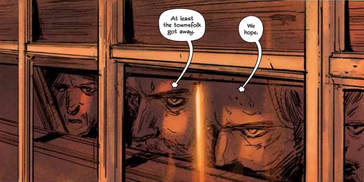Written by Joel T. Lewis The ‘victims’ of violence in Redlands number 1, set in 1977 Redlands, Florida are sexists, racists, and murderers. And what colorist extraordinaire (and now author) Jordie Bellaire and artist Vanesa Del Rey do to these pillars of white supremacy and the patriarchy via their three Witch protagonists is just about the most violent, terrifying, and vibrant carnage I've seen between the covers of a comic book. And it's damn satisfying. If you read comics even causally, chances are that you've seen the name Jordie Bellaire more than once. Jordie is one of the comic book industry's most talented colorists whose credits include Injection, The Punisher, Batman, Moon Knight, and Vision to name just a few. Regardless of the artist, or publisher for that matter, Bellaire elevates the comics she contributes to with a particular eye for shadow and textures. In her debut as a comic book writer, Jordie Bellaire begins Redlands issue 1 with a group of bigoted cops barricaded within their police station, watching in disbelief as the tree they tried to lynch our mysterious Witch protagonists from is engulfed in flame, and the would-be hang-ees are nowhere to be found. It's unclear what led to their attempted lynching or how they came to visit Redlands in the first place, but it becomes apparent very quickly that however monstrous the witches might be, the true villains of this story are the policemen. From the confederate flag flying in the background of the police station, to the racist and rape-culture rhetoric spouted by the Sheriff and his son, Bellaire quickly sets up a clever dichotomy of monstrous figures: the bigoted police force of 1977 (and there are clear hints that we may not have moved too far away from that type of bigotry in the modern day) and the horrific specters that terrorize them. The home invasion style horror narrative wastes no time in splattering blood all over the panels as the first police causality is decapitated rather gruesomely by a black wisp of shadow. This officer, dying while ushering a mysterious child inside the walls of the police station, thuds to the ground and the police rush to more thoroughly barricade the doors. The Sheriff, in response to his confused son’s questions about what to do, crunches the butt of his shotgun into his face. While this first impression of the Sheriff is by no means the vilest, it does a great job of showcasing this character's lack of compassion. Sent to check on the delinquent occupants of the station’s holding cell, the Sheriff's son proceeds to demonstrate serious prejudice against the people of color behind bars and casually refers to sexually assaulting women. Needless to say, as a reader at this point in the issue I was onboard with whatever messy end Bellaire had in store for these guys.  We then discover that the mysterious child who the police let inside the station is not what she appears as she twists and shifts among the shadows into a creature like a Minotaur and then into a terrifying banshee creature. In the confusion and violence caused by the mysterious child, the Sheriff's son finds himself outside taken hostage by another specter. The Sheriff, in an attempt to save his boy (whose nose he shattered just a few short pages ago) fires at the new specter, misses, and ends up killing his son instead. The razor sharp shadow, the empty nooses hanging from the tree outside the station, the shapeshifting child, and the three Witches we meet at the end of the issue are haunting and executed brilliantly by artist Vanesa Del Rey. One of my favorite visual elements of this issue was Del Rey’s beautiful and eerie moth who overhears the police’s sexual assault rhetoric. The detail and precision of Del Rey’s work is outstanding and the moth reminded me of the larger part those creatures played in my favorite thriller, The Silence of the Lambs. But where this book really stands out (appropriately) is in Bellaire’s masterful color work. Shadow, firelight, carnage, and gore are all brought to vivid life by one of the most prolific and talented colorists in comics today. It is Bellaire’s skill and use of shadow that allows the horror of this comic to succeed. By drenching her shape shifting child character in the right light, the terror you feel when you see her true form is made all the more dramatic. Fire burns brighter, blood shines redder, and shadow looms more ominous because of Bellaire’s mastery of color. There’s not much more to sum up in terms of plot for this first issue. Suffice it to say that a trio of Witches enact some gruesome, but righteous, violence on a group of bigots and I thoroughly enjoyed the ride. Horror is a great genre for critiquing injustice and bigotry as fear and cruelty can be applied to supernatural elements of fiction, as well as prejudice and supremacy in real life and Bellaire's narrative is fearless in its commentary on fear. This is a mature comic, and an important one. I cannot wait for issue 2 and I’m happy to have gotten in on the ground floor of what promises to be the long and illustrious career of Jordie Bellaire the author. Until next time, Geek On!
0 Comments
Leave a Reply. |
Archives
May 2024
|
|
© 2012-2025, Nerds That Geek LLC.
All Rights Reserved. |
uWeb Hosting by FatCow
